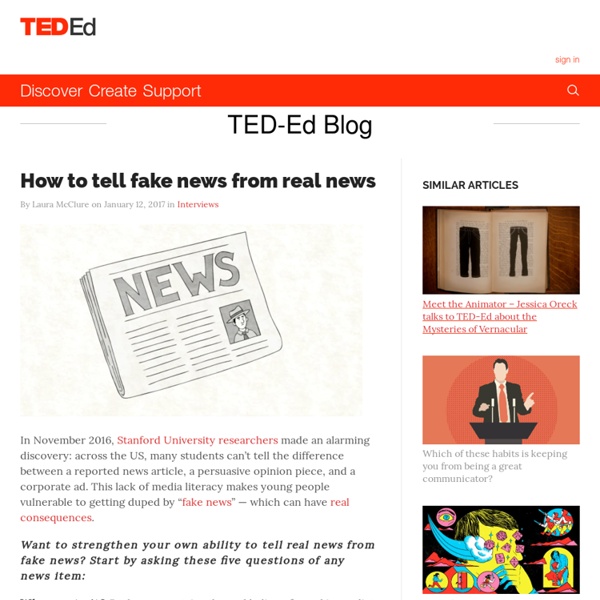We're climate researchers and our work was turned into fake news
Science is slow. It rests on painstaking research with accumulating evidence. This makes for an inherently uneasy relationship with the modern media age, especially once issues are politicised. The interaction between politics and media can be toxic for science, and climate change is a prominent example. Take the recent “deep freeze” along the US east coast.
Getting Out of the Filter Bubble: Finding The Real You Online
I recently had a great (and timely) conversation with one of the counselors from International School Manila at the EARCOS Teacher’s Conference in Kota Kinnabalu, Malaysia (check out all the resources from all of my sessions here). She said: “I wish there was a way to help students recognize what their online profile looks like to other people. They often think what they’re posting is great, but it can be hard for them to view it through someone else’s eyes.” The conversation was great because it’s such an important topic to highlight with students. And, it was timely, because this week, our Eduro Learning Facebook live topic is advanced search techniques, so it really got me thinking about how important it is for students to experience and reflect on the actually process and results of searching. And even if we do have those conversations, there’s another very specific challenge to having a true view of our digital footprint.
How to engage primary students with STEM in the classroom - Ian Fairhurst - ABC Splash -
On Wednesday 24 May at 4 pm (AEST) Splash will host a live chat with ICT integrator Ian Fairhurst. He will talk about the importance of STEM and will answer the questions you post during the event. In this article, Ian shares some of his ideas and classroom successes. Identifying and maximising student passion and creativity, and facilitating real world skills in learning activities is essential when teaching Science, Technology, Engineering and Maths (STEM) to primary students. The focus has shifted away from lessons focused around learning “content” to a stronger emphasis on learning and applying scientific skills, design thinking, and digital and design technology production skills.
10 Ways to Spot a Fake News Article - EasyBib Blog
For many of us, 2016 is going down as a year to forget. Election upsets, Zika, the Syrian crisis, and unfortunately tons of fake news about all of the above and everything in between. Denzel Washington was recently quoted as saying, “If you don’t read the newspaper, you’re uninformed. If you do read the newspaper, you’re misinformed.” So what should you do? You want to be informed, but a good deal of the information out there is incorrect or biased.
The tricks propagandists use to beat science
Back in the 1950s, health professionals became concerned that smoking was causing cancer. Then, in 1952, the popular magazine Reader’s Digest published “Cancer by the Carton,” an article about the increasing body of evidence that proved it. The article caused widespread shock and media coverage.
Digital content curation: For students! – Kay Oddone – Medium
Originally published on LinkingLearning I’ve been a fan of digital content curation for a long time. I’ve blogged about it on many occasions; first waxing lyrical about Diigo way back in 2011, then celebrating the new year in 2013 by suggesting resolutions to use curation to manage content overload and then reflecting on curation as an art form more recently. So what could I have left to write about, six years after my original post, and is digital content curation even relevant anymore? Recently it has come to my attention that everyone is looking for strategies to organise the huge amount of digital information we engage with every day, and I have started thinking that perhaps we don’t find content curation easy because we were never taught how to do it. My previous posts were always focused upon the value of curation for teachers and teacher librarians.
20+ ways to teach STEM for less than 30 cents per student
“Growing up, my parents never abandoned an opportunity to teach me about different cultures and ideologies,” says TED-Ed Innovative Educator Alicia C. Lane. “But it was my exploration-focused hometown of Huntsville, Alabama — also known as ‘Rocket City’ — that launched my interest in science and engineering.”
Fake news. It's complicated. – First Draft News – Medium
What can we do? We all play a crucial part in this ecosystem. Every time we passively accept information without double-checking, or share a post, image or video before we’ve verified it, we’re adding to the noise and confusion. The ecosystem is now so polluted, we have to take responsibility for independently checking what we see online. In the weeks after the US election, we saw journalists track down fake news creators.
How to outsmart fake news in your Facebook feed
It doesn't have to be this way. Fake news is actually really easy to spot -- if you know how. Consider this your New Media Literacy Guide. 1.
"fake news" not new 2 clicks
Donald Trump may well be remembered as the president who cried “fake news.” It started after the inauguration, when he used it to discredit stories about the size of the crowd at his inauguration. He hasn’t let up since, labeling any criticism and negative coverage as “fake.” Just in time for awards season, he rolled out his “Fake News Awards” and, in true Trumpian fashion, it appears he is convinced that he invented the term.



